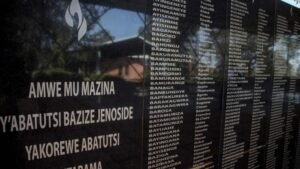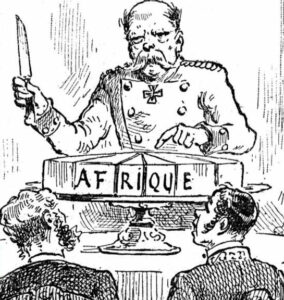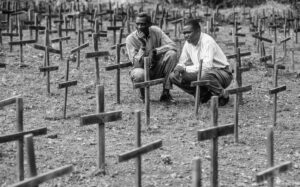Details Outlining the Genocide Against the Tutsi
Many people tend to think that in 1994 a massacre just broke out in Rwanda, and ended with the murders of nearly a million people, mostly Tutsi. That is not quite how it happened. There were many moves and decisions throughout the history of Rwanda that caused the hate and division that resulted in the 1994 Genocide Against the Tutsi. It is a complex, deep story that truly deserves its own time and space. First and foremost, it is imperative to visit the Genocide Museum in Kigali, they give a full just history of the genocide.

A brief rundown is as follows.
In the beginning of the history, Rwanda was separated by clans (ubwoko) and in the 1700, formed about eight kingdoms.
The Kingdom of Rwanda, ruled by the Tutsi Nyiginya clan, became the dominant kingdom from the mid-eighteenth century, expanding through a process of conquest and assimilation, and achieving its greatest extent under the reign of King Kigeli Rwabugiri in 1853–1895. Rwabugiri expanded the kingdom west and north, and initiated administrative reforms which caused a rift to grow between the Hutu and Tutsi populations. These included uburetwa, a system of forced labor which Hutu had to perform to regain access to land seized from them, and ubuhake, under which Tutsi patrons ceded cattle to Hutu or Tutsi clients in exchange for economic and personal service.
Please note, that prior to and during colonial rule, which took place under Germany from about 1887 and then, under Belgium, in 1917, Rwanda had some eighteen clans defined primarily along lines of kinship. So, although the terms Hutu and Tutsi were in use, they referred to individuals rather than to groups, and the distinction between them was based on lineage, not ethnicity. In fact, one could often move from one status to another. Also, at that time, Hutu and Tutsi were often treated differently but they shared the same language and culture; the same clan names; same customs; and the symbols of kingship served as a powerful unifying bond between them.
If you don’t know about the Berlin Conference of 1884, it is vital to understand what happened there. Many of the affects of that conference still plague many African countries to this day. The Berlin Conference, in short, was a meeting where European colonization was regulated and African tradelines were created…without the input of any African nations or bodies. During this conference Rwanda and neighboring Burundi were assigned to Germany and Germany established a presence in the country in 1897. It was German policy (with help of the kind) to rule the country through the Rwandan monarchy. It was German colonists who favored Tutsi over Hutu for administrative roles, citing a belief they thought they were migrants from Ethiopia and racially superior.

During World War I, Belgian forces took control of Rwanda and Burundi and in 1926 began a policy of a more direct colonial rule. The Beligan modernized the Rwandan economy, but continued with Tutsi supremacy which left the Hutu disenfranchised. In 1935, Belgium introduced a permanent division of the population. The introduced three ethnic groups. They measured and placed Rwandans into these groups with Hutu representing 84% of the population, Tutsi about 15% and Twa about 1%. They also began compulsory identity cards which labelled each individual within the chosen ethnicity. Before, it was possible to move between the groups with financial access, now the cards prevented any movement at all. As a result, the previously unrestrictive socio-economic groups now were made into rigid ethnic groups. To make matters worse, ethnic identities were reshaped and mythologized by the colonizers. Christian missionaries promoted theories that provided the basis for anti-Tutsi propaganda.
After World War II, a Hutu emancipation movement began to grow in Rwanda, Catholic missionaries increasingly viewed themselves as responsible for empowering the underprivileged Hutu rather than the Tutsi elite, leading rapidly to the formation of a sizeable Hutu clergy and educated elite that provided a new counterbalance to the established political order. The monarchy and prominent Tutsis sensed the growing influence of the Hutu and began to agitate for immediate independence on their own terms. On 1 November 1959 Dominique Mbonyumutwa, a Hutu sub-chief, was attacked close to his home by supporters of the pro-Tutsi party. Mbonyumutwa survived, but rumors began spreading that he had been killed. Hutu activists responded by killing Tutsis, both the elite and ordinary civilians, marking the beginning of the Rwandan Revolution mid-year commune elections which returned an overwhelming Hutu majority. A Belgian effort to create an independent Ruanda-Urundi with Tutsi-Hutu power sharing failed, largely due to escalating violence. At the urging of the UN, the Belgian government divided Ruanda-Urundi into two separate countries, Rwanda and Burundi.
Through this, in 1962, Rwanda became an independent, however the emotions were still greatly divide. Honestly, the next thirty years is a chaos of motions and movement, going from military rule to obscene propaganda, training of children soldiers and so much more. In 1990, the Rwandan Patriotic Front(RPF), a rebel group composed of nearly 500,0000 Tutsi refugees, invaded northern Rwanda from their base in Uganda, initiating the Rwandan civil war. The group condemned the Hutu-dominated government for failing to democratize and confront the problems facing these refugees. Neither side was able to gain a decisive advantage in the war, but by 1992 it had weakened Habyarimana’s authority; mass demonstrations forced him into a coalition with the domestic opposition and eventually to sign the 1993 Arusha Accords with the RPF. The cease-fire ended on 6 April 1994 when Habyarimana’s plane was shot down near Kigali Airport, killing him. The shooting down of the plane served as the catalyst for the Rwandan Genocide, which began within a few hours. Over the course of approximately 100 days, between 500,000 and 1,000,000 Tutsi and politically moderate Hutu were killed in well-planned attacks on the orders of the interim government. Many Twa were also killed, despite not being directly targeted.

During this time of the genocide no other country came in to assist or help and Rwanda was on its own to find a way. The Tutsi RPF restarted their offensive, and took control of the country methodically, gaining control of the whole country by mid-July. The international response to the genocide was limited, with major powers reluctant to strengthen the already overstretched UN peacekeeping force. When the RPF took over, approximately two million Hutu fled to neighboring countries, in particular Zaire, fearing reprisals; additionally, the RPF-led army was a key belligerent in the First and Second Congo Wars. Within Rwanda, a period of reconciliation and justice began, with the establishment of the International Criminal Tribunal for Rwanda (ICTR) and the reintroduction of Gacaca, a traditional village court system.
The purpose of this article is to show you that the genocide was not an overnight movement. There was decades of hate, separatism, propaganda that spilled over into an unregulated boiling pot. There is only Rwandans now, no more ethnic groups or talks of ethnic groups. There is significant investments in counseling, courts and justice systems. Restitution and restorative practices. Building upon the new generation to create the workforce and mindset that is needed for a progressive country. Rwanda is dedicated to making herself better and her people stronger.
Comments:
- NO COMMENTS YET
- Add Your Comment:







